Agricultural and Biological Research
RNI # 24/103/2012-R1
To observe how various photoperiod regimes and culture media affect in vitro cultures, particularly with regard to direct shoot growth, callus induction and organogenesis. A variety of six cultural media (MS medium, Nitsch and Nitsch, WPM, Schenk and Hildebrant medium, White's medium, and Khudson Solution C) and photoperiod regimes (16:8, 14:10, 12:12, and 8:16) were used to plant the nodal segment, shoot apex, and leaf explant of the Sindhuri cultivar of pomegranate. The leaf explant supplemented with the most responsive level (1.0 mg/l BAP+1.0 mg/l NAA) showed the largest induction of callus. In shoot apex explants treated with WPM at the most responsive dosage (2.5 mg/l BAP), maximum shoot bud induction was also noted. For de novo shoot regeneration from callus culture, WPM supplemented with 1.0 mg/l BAP+2.0 mg/l NAA was shown to be the most effective. WPM and MS media were determined to be the most effective among all the media for callus induction, shoot bud proliferation, and de novo shoot formation. All the photoperiod regimes investigated, the 14:10 hour regime was shown to be the most effective for shoot bud induction, callus differentiation, and de novo shoot development.
